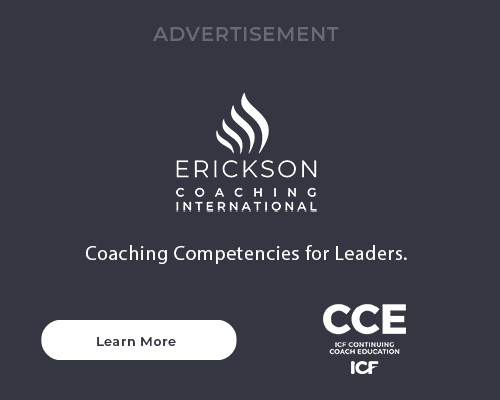5 Steps to Creating a Robust Coaching Culture
The business landscape continues to evolve at a record pace. Forward-thinking organizations are turning to coaching to help them remain agile and competitive while also committing to the development of their people.
Establishing a robust coaching culture is a strategic imperative, vital for cultivating a cohesive and engaging environment, but you may be wondering how exactly to do this.
For nearly a decade, the International Coaching Federation (ICF) and the Human Capital Institute (HCI) have joined forces to explore the key components of a strong coaching culture. In their latest report, Defining New Coaching Cultures, they advise organizations to invest in the following five approaches to build an impactful culture.
Adopt a Coaching Framework and Tools
I firmly believe that having a framework for your coaching culture is like having a practical roadmap that will lead you to an abundance of benefits, including increased leadership, employee engagement, and commitment.
Over the past decade, ICF and HCI have identified the following six elements of a strong coaching culture:
- Employees value coaching.
- Senior executives value coaching.
- Managers/leaders develop coaching skills through accredited coaching education or training.
- Coaching has a dedicated line item in the budget.
- Employees have equal access to coaching.
- Three coaching modalities are present: internal coaches, external coaches, and managers/leaders using coaching skills.
These six components can help create a successful framework for your organization’s coaching culture.
Creating a framework is just the first step; along with a solid framework, you should also consider how you will determine success. Measuring results begins with understanding the desired return on expectations (ROE). The benefits of a coaching culture can include improved communication and collaboration, optimized performance, and heightened engagement across all levels of employment. By measuring these results through ROE, you can track both quantitative and qualitative results of the program. A variety of tools exist to help track ROE and return on investment (ROI), including employee surveys, measurement/evaluation software, and online tools like CoachHub and Loupe that use artificial intelligence (AI) to show impact and strengthen coaching engagements.
Study Emerging Coaching Trends
Keeping your organization competitive and staying up-to-date on emerging trends is important for any business initiative. A coaching culture is no exception. By studying these trends, you can connect them to organizational goals and prioritize what is most important to your organization and people.
The report reveals a broad array of challenges to overcome and opportunities to be embraced by organizational coaching programs. Barriers such as burnout and employee turnover — as well as the influence of technological advancements like digital coaching platforms and the task of coaching an increasingly remote workforce — have become the primary obstacles.
Meanwhile, organizational initiatives such as Diversity, Equity, and Inclusion (DEI), upskilling, and employee well-being represent opportunities for organizations to create inclusive and empowered work environments.
Utilize New Coaching Modalities
The more coaching modalities available, generally the more accessible coaching is to employees at all levels in the organization. In the report, 38% of responding organizations use all three coaching modalities of internal coach practitioners, external coach practitioners, and managers and leaders using coaching skills. The high adoption rate of the three coaching modalities is attributable to the evolving view of coaching as a sustainable approach to people management.
In addition to these modalities, more organizations are using emerging technologies like coaching platforms to amplify the reach, quality, and impact of coaching. For example, Coach Vici utilizes a research-backed AI chatbot to make coaching more accessible, and AceUp combines technology, AI, and a systemic coaching approach to drive team and organizational transformation.
Commit to Standards by Pursuing Accreditation and Credentialing
Organizations with strong coaching cultures have committed to coaching standards, which helps to ensure their leaders and employees receive effective coaching.
Award-winning organizations like AstraZeneca and Intel use ICF-credentialed coaches in various ways throughout their coaching cultures. Plus, many organizations with strong coaching cultures help their internal coaches — and even managers and leaders — pursue ICF credentials. ICF-credentialed coaches meet stringent education and experience requirements and demonstrate a thorough understanding of professional standards.
Organizations will also typically invest in education or training for their internal coaches, managers, and leaders. According to the report, 53% of organizations invest in coach-specific training for internal coach practitioners from programs accredited by a professional coaching organization like ICF. Thirty-four percent invest in these programs for their managers and leaders. For the ultimate alignment between coaching and organizational culture, companies with strong, mature coaching cultures will often create their own internal coaching education programs and seek accreditation.
Network With Other Forward-Thinking Organizations
Organizations that invest in coaching cultures are innovative and ahead of their competition. Being in this position can sometimes make it difficult to find people who are striving for similar goals and encountering similar challenges. At ICF, we are dedicated to providing a community for you.
Through ICF Coaching in Organizations membership, you gain access to an exclusive, global network that connects like-minded individuals within coaching-centric organizations who are ready to share best practices and work together to empower their organization’s people through coaching. ICF member organizations are also empowered to leverage the entire ICF ecosystem, from research on emerging trends and technologies to concierge-level support throughout the accreditation and credentialing processes. Access to these resources and support can help you bring together the first four steps in this article.
Summary
Companies that emphasize and invest in a strong coaching culture are well-positioned to unlock the full potential of their workforce, drive sustainable growth, and achieve long-term success in an ever-evolving business landscape. Taking the five steps discussed above ensures that your organization’s coaching initiatives align with best practices and industry standards. If you’re ready to join other organizations actively committed to building stronger coaching cultures, contact the ICF Coaching in Organizations team today.



